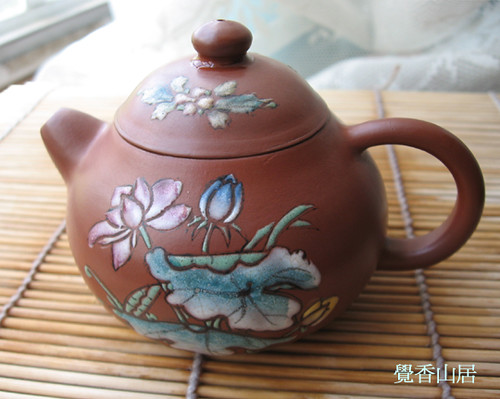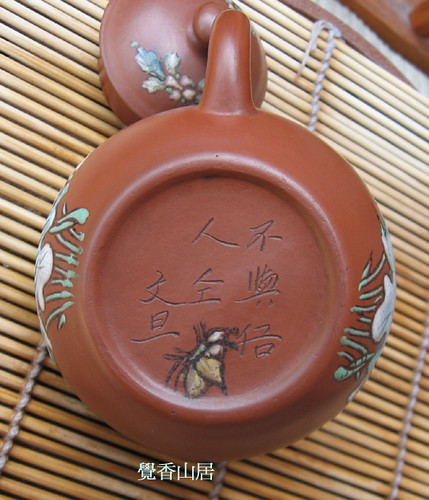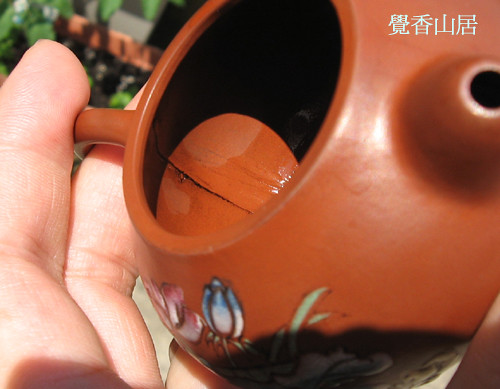
Okay, I accept, I can't resist beautiful things. It's too difficult for me to not being absorbed to these objects. So, yes, basically I was just attracted by its beauty when I saw it.
The pot takes the shape of one of the prototypes of traditional kongfu teapots, 文旦 Wendan. 文旦柚 Wendan you is the Chinese name for Pomelo, a citrus fruit native to Southeast Asia and widely cultivated in south China and Taiwan. A Wendan pot with a slightly narrowed top and a large bellyed base, is said, according to one view, to resemble this gracefully shaped fruit. The curved outline moving from the lid to the base particularly pleases my eyes.




(A wendan harvest festival in Bali, Taipei, Taiwan)
The characteristic decoration on the pot, imitating some Qing syle partial-glazed Yixing Zishawares, depics lotus growing out of mud under water without being contaminated -- a perfect analogy to the virtue of detachment from worldly affairs. Now-a-days, it is quite rare to find a glazed zisha teapot, especially a partial-glazed one like this. It is said that the glaze techniques applied to zishaware was developed to meet the sumptuous demand in the mid-Qing court, and thus a dead end fashion. It is criticized for its excessiveness at the price of diminishing the unique feature of zishaware, the permeability, which makes zisha the best media in communication with tea. However, the partial-glaze technique is forgivable, I think, for it makes the pot more appealing without suffocating it.

My first impression on this pot when it physically arrived in my hands (I bought it online) is delicacy. Rather thin walled and sized so tiny compared with most of my mid to large sized zisha pots, it finalized my knowledge of the so called 水平壺 Shui-ping hu fashion. This type of teapot, nearly fanatically favored in kongfu tea ceremony, usually comes with a standard volume of 120cc, more or less. No craftsman's seal can be found anywhere on the pot but it is inscribed with words "不與俗人仝 文旦" (lit. "Not mixed with vulgarians. Wendan") on the base. (仝=同)

A looking to the inside of the pot reveals a seam on the back wall. This can be, according to some convention, a sign for the pot being genuinely handmade (and thus more valuable). But again, it can't be taken as granted!

The pot is made of 朱泥 Zhu-ni or red clay for sure, because the color is vermeil and I can see fine wrinkles on the surface. A noticeable change of color can be observed after pouring hot water in and on it; and more remarkably, its color would turn into dark purple when the water vaporized on the surface of the pot.
So far, I've only tried two Taiwanese high mountain oolongs, namely, 金萱 jin-xuan and 梨山 Li-shan, in this pot, and it performed quite well to these lightly roasted teas.

(The pot, the last infusion, and the spent leaves of Lishan_
Hi,
ReplyDeleteI did a search in google with the characters 水平壶, many chinese sites sell this type of pot, however living in Canada and unable to write chinese but only speak it. I find it next to impossible to buy from chinese sites. I am hoping that you can assist in recommending any english friendly teaware sites in the mainland or taiwan? that are willing to sell and ship QUALITY teaware to overseas customers thanks.
Hi Terence,
ReplyDeleteI totally understand your situation - in fact I had the same difficulties even I could both speak and write Chinese. It's not a language problem but rather a matter of access. Have you tried things such as Ebay? I know some teaware sellers' sites there, and sometime buy things from there -- but again, there is no control on "quality" -- all depends on your experience, and sometimes, luck (or bad luck)!